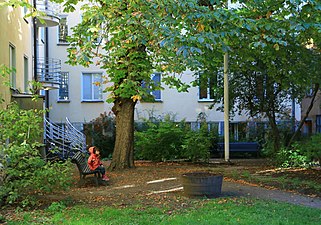Kvarteret Andromeda

Kvarteret Andromeda är ett långsmalt kvarter i Gamla stan, Stockholm. Det sträcker sig i nord-sydlig riktning mellan Själagårdsgatan samt Brända tomten i väster och Baggensgatan i öster. I norr begränsas kvarteret av Köpmansgatan och i söder av Tyska skolgränd. Kvarteret består idag av 13 fastigheter.
Namnet
Gamla stans kvarter är övervägande döpta efter begrepp (främst gudar) ur den grekiska och romerska mytologin, så även kvarteret Andromeda. Andromeda var i den grekiska mytologin dotter till Kefeus och Kassiopeia. Andromeda är även namnet på en stjärnbild på norra stjärnhimlen.
Fastigheter (urval)

- Andromeda 2, Själagårdsgatan 13, här är låg fram till 1531 Stockholms själagård, stadens fattighus. Mellan 1666 och 1814 fanns här en trivialskola (föregångaren till dagens Sankt Nicolai skola). Huset revs 1933, men källaren med medeltida murverk bevarades under ett nybygge som ritades av Carl Åkerblad och stod klart 1936.[1]
- Andromeda 6, Själagårdsgatan 5: Huset bevarar medeltida murverk upp till tre våningars höjd och ett intill liggande gårdshus upp till fyra våningar.[2]
- Andromeda 7, Själagårdsgatan 3: Upp till våningen tre trappor har byggnaden delvis medeltida murverk, byggnadsminne sedan 1998.[3]
- Andromeda 10, Baggensgatan 14: Här bodde Elisabeth Olin som var en berömd operasångerska på Gustav III:s tid.
- Andromeda 13, Själagårdsgatan 15 uppfördes 1939 efter ritningar av arkitekt Curt Björklund.
Bilder
- Kvarteret Andromeda (t.v.) mot Själagårdsgatan 2009.
- Andromeda 7, 6, 5 och 4 sedda från Brända tomten.
- Andromeda 7, bottenvåning och våning 1 trappa.
- Andromeda 2, gården mot Baggensgatan.
- Baggensgatan söderut med Andromeda 10 till höger.
Referenser
Noter
- ^ ”Själagården i Gamla Stan i Stockholm”. Arkiverad från originalet den 17 juli 2019. https://web.archive.org/web/20190717041410/http://www.stockholmgamlastan.se/historia/sjuka-aldre/sjalagarden.php. Läst 9 augusti 2019.
- ^ Fastigheten Andromeda 6, Gamla Stan, Byggnadsinventering, 1984
- ^ RAÄ:s bebyggelseregister: KV ANDROMEDA 7.
Källor
- Kvarteret Andromeda, Gamla Stan, medeltida murverk.
- Hasselblad, Björn; Lindström, Frans (1979). Stockholmskvarter: vad kvartersnamnen berättar. Stockholm: AWE/Geber. sid. 12. Libris 7219146. ISBN 91-20-06252-4
- Göran Söderström (2016). Gamla stan, Slottet och Storkyrkan. Lind & Co. sid. 81-82. ISBN 978-91-7461-381-0
Externa länkar
 Wikimedia Commons har media som rör Kvarteret Andromeda.
Wikimedia Commons har media som rör Kvarteret Andromeda.
Media som används på denna webbplats
Författare/Upphovsman: User:Kildor
, Licens: CC BY-SA 3.0
See about CoA blazoning: [Expand]
Författare/Upphovsman: Holger.Ellgaard, Licens: CC BY-SA 4.0
Andromeda 7, Själagårdsgatan 3
Författare/Upphovsman: Holger.Ellgaard, Licens: CC BY-SA 3.0
Själagårdsgatan i Gamla stan, Stockholm
Författare/Upphovsman: Øyvind Holmstad, Licens: CC BY-SA 4.0
Green city environment.
Författare/Upphovsman: Holger.Ellgaard, Licens: CC BY-SA 4.0
Kvarteret Andromeda, gatuskylt
Kvarteret Andromeda
Författare/Upphovsman: Holger.Ellgaard, Licens: CC BY-SA 3.0
äldre gatuskylt i Stockholm
Författare/Upphovsman: Jorge Láscar from Melbourne, Australia, Licens: CC BY 2.0
Gamla stan (The Old Town), is the old town of Stockholm, Sweden. Gamla stan consists primarily of the island Stadsholmen.
The town dates back to the 13th century, and consists of medieval alleyways, cobbled streets, and archaic architecture. North German architecture has had a strong influence in the Old Town's construction.
Stortorget is the name of the scenic large square in the centre of Gamla Stan, which is surrounded by old merchants' houses including the Stockholm Stock Exchange Building. The square was the site of the Stockholm Bloodbath, where Swedish noblemen were massacred by the Danish King Christian II in November, 1520. The following revolt and civil war led to the dissolution of the Kalmar Union and the subsequent election of King Gustav I.
As well as being home to the Stockholm Cathedral, the Nobel Museum, and the Riddarholm church, Gamla stan also boasts Kungliga slottet, Sweden's baroque Royal Palace, built in the 18th century after the previous palace Tre Kronor burned down. The House of Nobility (Riddarhuset) is on the north-western corner of Gamla stan.
The restaurant Den gyldene freden is located on Österlånggatan. It has been in business since 1722 and according to the Guinness Book of Records is the oldest existing restaurant with an unaltered interior. A statue of St. George and the Dragon (sculpted by Bernt Notke) can be found in the Stockholm Cathedral, while Riddarholmskyrkan is the royal burial church. Bollhustäppan, a small courtyard at Slottsbacken behind Finska kyrkan, just south of the main approach to the Royal Palace, is home to one of the smallest statues in Sweden, a little boy in wrought iron. The plaque just below the statue says its name "Järnpojken" ("The Iron Boy"). It was created by Liss Eriksson in 1967.
From the mid 19th to the mid 20th century Gamla stan was considered a slum, many of its historical buildings left in disrepair, and just after WW2, several blocks together five alleys were demolished for the enlargement of the Riksdag (see Brantingtorget). From the 1980s, however, it has become a tourist attraction as the charm of its medieval, Renaissance architecture and later additions have been valued by later generations.
While the archaeology of the 370 properties in Gamla stan remains poorly documented, recent inventories done by volunteers have shown many buildings previously dated to the 17th and 18th centuries, can be up to 300 years older. There is also a metro station in Gamla Stan with the same name [Wikipedia.org]Författare/Upphovsman: Egen avfotografering, http://mstyslav-chernov.com/, Licens: CC BY-SA 4.0
Winding streets of Stockholm (Baggensgatan). Sweden, Northern Europe.














